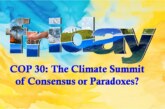Dr. Arvind Kumar*
Cities are fast emerging as the major hub of sustainable development activities and are destined to play very important role in the realization of sustainable development goals (SDGs). History is witness to the fact that cities have played a significant role in the emergence and growth of civilizations throughout the world. Burgeoning population and increasing pace of migration from rural areas to urban areas, a phenomenon known as urbanization, globally has culminated in the expansion of cities along with creation of new urban habitats.

Currently, 55% of the global population lives in urban areas and this is expected to increase to 68% by 2050. Interestingly, the world’s urban population has registered rapid strides from 751 million in 1950 to 4.46 billion in 2021 and is likely to grow to 6.68 billion by 2050, adding about 2.22 billion people to urban habitats. And the bulk of the projected growth of global urban population, say about 90%, is expected to occur in Asia and Africa between 2021 and 2050. According to the projections of the Population Division of the UN Department of Economic and Social Affairs, India, China and Nigeria together will account for 35% of the projected growth of the world’s population, and by 2050, it is projected that India will have added 416 million urban dwellers.Not to forget, cities are by far the largest contributors to GHG emissions, they consume 75% of the world’s resources and produce 80% of CO2 emissions (UN-Habitat 2005).
India is alive to the issue of burgeoning growth of its urban population and the Government of India is taking suitable measures keeping in consonance with the emerging requirements to meet the emergent urban needs. On December 17 this year, Prime Minister Shri Narendra Modi virtually inaugurated All India Mayors Conference via video conference While referring to the recent developments in the ancient city of Varanasi, PM Modi in his virtual inaugural address, recalled his statement that the development of Kashi could be a roadmap for the entire country. Asserting that most of the cities in India are traditional cities that had been developed in a traditional way, Emphasizing that the antiquity of these cities was equally important in the present era of modernization, PM Modi remarked that these cities could teach us as to how to preserve the heritage and local skills, and he further insisted that destroying the existing structures was not the way rather emphasis should be on rejuvenation and preservation that could be facilitated in accordance with the needs of modern times.
While calling for healthy competition between the cities for cleanliness and wondering whether there could be new categories for recognizing the cities that are making the best efforts to achieve cleanliness along with the best performing cities, PM Modi also insisted on the beautification of cities along with cleanliness. He also called upon the Mayors to create a sense of healthy competition between the wards of their cities in this regard. Concomitantly, the Mayors were also urged to run programmes related to ‘Azadi ka Amrit Mahotsav’ such as freedom struggle themed ‘rangoli’ competitions, song-competition on freedom struggle and Lullaby (Lori) competition, which the Prime Minister has been insisting on, in his speeches and Mann ki Baat. He also suggested that Mayors should find out and celebrate birthdays of the cities and celebrate them.

While suggesting that cities with rivers should celebrate the River Festival (Nadi Utsav), PM Modi also stressed the need to spread the glory of the rivers so that people take pride in them and keep them clean. “Rivers should be brought back to the centre of city life. This will bring a new life to your cities.” said the Prime Minister. While calling upon Mayors to revitalize the campaign against the elimination of single-use plastic, he asked them to look for ways of creating wealth from waste. He suggested many tasks for Mayors, such as getting in touch with NCC units of the city and create groups to maintain statues of the city; organizing speeches on the personalities in the spirit of ‘Azadi Ka Amrit Mahotsav’; and identifying a place in the city and creating a monument in sync with the ‘Azadi Ka Amrit Mahotsav’ through PPP mode etc.
Referring to the ‘One District One Product’ programme, PM Modi asked Mayors to push for a unique identity of their cities promoted by some unique product or place in the city. He also exhorted them to develop people-friendly thinking with regard to various aspects of urban life. Describing the cities as the driving force of nation’s economy and emphasizing on making the city a hub of a vibrant economy, PM Modi called upon Mayors to create a holistic system where all facilities develop simultaneously to generate an ecosystem that invites and promotes economic activity…
Reiterating the need to strengthen MSMEs in nation’s development model, PM Modi emphasized the role of street vendors and described them as“part of our own journey, we will see their troubles every moment. For them, we have brought PM Svanidhi Yojana. This plan is very good. Make a list of them in your city and teach them to do mobile phone transactions. This will facilitate bank finance on much better terms.” Calling upon Mayors to give their suggestions from their experiences for the development of Kashi, PM Modi said: “I will be grateful for your suggestions and I will be your first student”.
Keeping in the geographical expanse of India and its burgeoning population, there arises a question as to whether existing and emerging cities develop into sprawling chaotic slums – with unbreathable air, uncontrolled emission of greenhouse gases and impoverished populations often bereft of food and clean water – or become truly sustainable cities, and much of this depends on howthese new urban areas are planned and how the existing cities are managed environmentally. With regard to the future of cities, there are differing opinions of experts from different disciplines. While many economists argue that population growth is required to generate wealth and that urbanization significantly reduces environmental impact; nevertheless, other experts apprehend that the cities are becoming unmanageable – too unwieldy to adapt to rising temperatures and rising sea levels, apart from being prone to pollution, water shortage and ill health.
It is interesting to know that government is focusing its attention on investing in clean transport, water, sewage, renewable energy planning wellbeing and good affordable housing for all along with taking into consideration the neglected urban areas. It is now an accepted fact that more than 80% of global GDP is generated in cities and as such urbanization can contribute to sustainable growth given the fact that urbanization is managed well by enhancing productivity, allowing innovation and new ideas to emerge.We have to explore human-infrastructure-environment interactions at multiple scales, advance fundamental science, interdisciplinary urban-systems science, multi-infrastructure design and science-policy linkages. We have to study resource requirements of future urbanization, infrastructure transition pathways, and the response, recovery and adaptation of urban systems under multiple hazards. We must connect cities to surrounding earth systems to mitigate extreme heat, wind, flooding and pollution and develop integrated multi-infrastructure models that address the nexus of land, buildings, energy, water, food, and mobility systems by designing nature-based solutions and next-generation cyberphysical technologies. Collectively we should highlight the critical emerging urban agendas, such as developing water-sensitive cities, net-zero carbon energy systems, resilient cities, healthy communities, and smart cities only then one can hope that in the wake of suggestions given by PM Modi in tandem with other suggestions of experts, the process of urbanization in India can gather momentum in a sustainable manner.
*President, India Water Foundation



